Loading ...
Loading ...
Loading ...

ENGLISH
10
Usage (Fig.A)
CAUTION: Ensure fastener and/or system will
withstand the level of torque generated by the tool.
Excessive torque may cause breakage and possible
personalinjury.
1. Place the accessory on the fastener head. Keep the tool
pointed straight at thefastener.
2. Press variable speed trigger switch
3
to start operation.
Release variable speed trigger switch to stop operation.
Always check torque with a torque wrench, as the
Worklights (Fig.A)
CAUTION: Do not stare into worklight. Serious eye
injury couldresult.
There are three worklights
8
located around the chuck
collar
5
. The worklights are activated when the trigger
switch is depressed. When the trigger is released, the
worklight will stay illuminated for up to 20 seconds. If
the trigger switch remains depressed, the worklights will
remainon.
NOTE: The worklights are for lighting the immediate work
surface and are not intended to be used as aflashlight.
Variable Speed Trigger and Forward/
Reverse Control Button (Fig.A)
The tool is turned on and off by pulling and releasing the
variable speed trigger
3
. The farther the trigger is depressed,
the higher the speed of the tool. Your tool is equipped with
a brake. The chuck will stop as soon as the trigger switch is
fullyreleased.
A forward/reverse control button
4
determines the
rotational direction of the tool and also serves as a
lock-offbutton.
• To select forward rotation (clockwise), release the trigger
and depress the forward/reverse control button on the
right side of thetool.
• To select reverse (counterclockwise), depress the
forward/reverse control button on the left side of
thetool.
NOTE: The center position of the control button locks the
tool in the off position. When changing the position of the
control button, be sure the trigger isreleased.
NOTE: Continuous use in variable speed range is not
recommended. It may damage the switch and should
beavoided.
NOTE: The first time the tool is run after changing the
direction of rotation, you may hear a click on start up. This is
normal and does not indicate aproblem.
Proper Hand Position (Fig.I)
WARNING: To reduce the risk of serious personal
injury, ALWAYS use proper hand position as shown.
WARNING: To reduce the risk of serious personal
injury, ALWAYS hold securely in anticipation of a
suddenreaction.
Proper hand position requires one hand on the main
handle
15
.
Installing and Removing the Battery Pack
(Fig.H)
NOTE: For best results, make sure your battery pack is
fullycharged.
To install the battery pack
1
into the tool handle, align the
battery pack with the rails inside the tool’s handle and slide
it into the handle until the battery pack is firmly seated in the
tool and ensure that it does notdisengage.
To remove the battery pack from the tool, press the release
button
2
and firmly pull the battery pack out of the tool
handle. Insert it into the charger as described in the charger
section of thismanual.
OPERATION
WARNING: To reduce the risk of serious personal
injury, turn unit off and remove the battery pack
before making any adjustments or removing/
installing attachments or accessories. An
accidental start‑up can causeinjury.
Quick-Release Chuck (Fig.A, J)
WARNING: Use only impact accessories. Non‑impact
accessories may break and cause a hazardous
condition. Inspect accessory prior to use to ensure that
it con tains nocracks.
NOTE: The chuck
6
accepts 1/4" (6.35 mm) hex accessories
and 1" (25.4 mm) bit tips only.
Place the forward/reverse button
4
in the lock-off
(center) position and remove battery pack before
changingaccessories.
To install an accessory, fully insert the accessory. The
accessory is locked into place (Fig.J).
To remove an accessory, pull the chuck collar
5
away from
the front of the tool. Remove the accessory (Fig.J).
The lanyard attachment point
11
is for attaching
appropriate lanyards with locking carabiner ends for use at
height, 6.5ft (2 m) maximum length, rated for at least the
weight identified on the tool lanyard attachment point label.
Refer to FigureD.
Installing the Battery Strap Carabiner to
the Lanyard Attachment Point
WARNING: DO NOT attach the lanyard to the battery
strap. Lanyards should only be attached to the lanyard
attachmentpoint.
The carabiner at the end of the battery strap
12
, should be
opened and then attached to the lanyard attachment point.
To open the carabiner:
1. Install battery intotool.
2. Flip open the carabiner tab
13
.
3. Pull the tabupward.
4. Move the carabiner locking arm
14
out to open.
5. Attach the carabiner locking arm to the lanyard
attachment point
11
.
6. Move the locking arm back into place, push the tab back
down so the pin engages the lockingarm.
7. The tool is now ready for a lanyard. Refer to Figure D.
Loading ...
Loading ...
Loading ...
